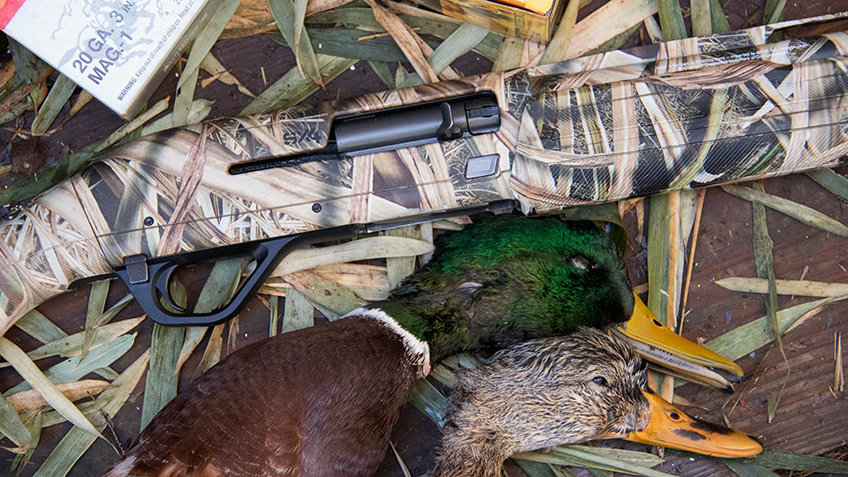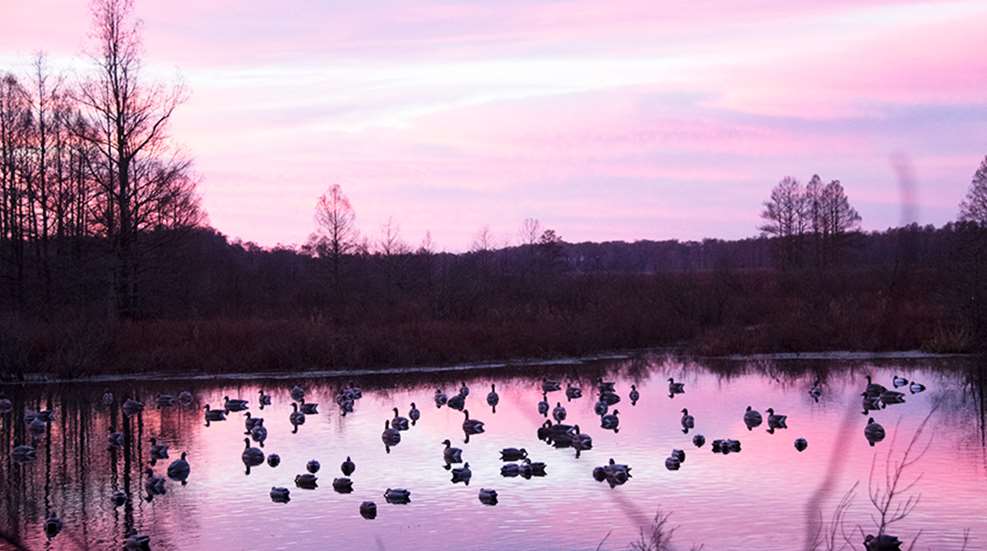
An hour before dawn Jackie Van Cleave’s War Eagle roared away from the marina into the dark waters. Dave Ransom, who helps with Jackie’s duck-hunting operations, stood at the helm and guided the boat through the cold December darkness into more open water near the center of the lake. Black pillars appeared against the starlit horizon—the towering cypress trees that have become a symbol of the lake—and we steered directly for them. The motor slacked as Dave directed the boat from the main body of the lake into a narrow channel lined by massive trunks, and soon to my left and right I could see cypress stumps bulging from the black water outside the beam of the War Eagle’s bow light.
“You gotta be careful when you’re driving around here in the dark,” Jackie shouted. I nodded. Hitting one of those cypress knees at full throttle would reduce even the most robust watercraft to rubble, and that’s not to say what might happen to the passengers on board.
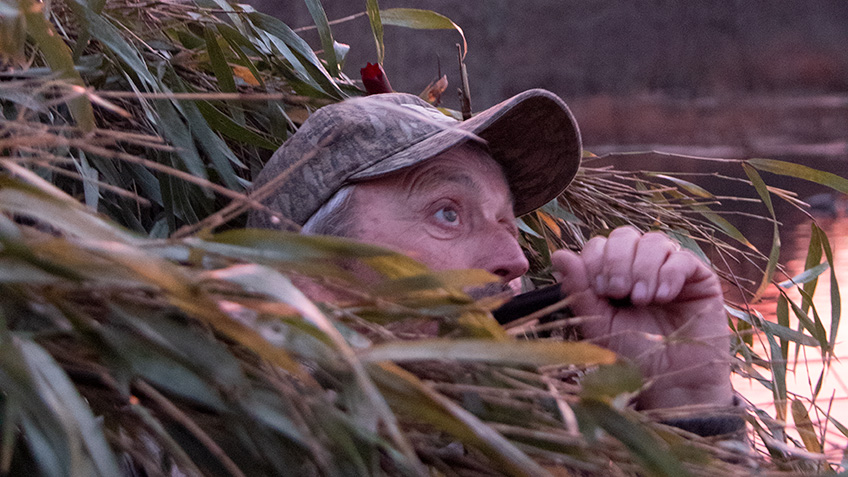
We navigated the ever-narrowing channels until we were in a finger of dark water not much wider than the boat’s hull. The bow light illuminated a floating dock that held a duck blind.
“Here we are,” Jackie said with a smile as he stood up and got ready to offload our guns and gear. “Home sweet home.”
This is Reelfoot Lake. Located in northwestern Tennessee, it was formed by a natural disaster so violent it caused the Mississippi River to reverse course. On December 16, 1811, shifting plates along the New Madrid Fault generated a massive earthquake estimated at about 7.7 on the Richter scale, and that was followed by a magnitude 7.4 aftershock the same day. That quake—the largest ever recorded east of the Rockies—caused the Mississippi River to flow backward and generated waves up to 20 feet tall, redefining the river’s course and wiping out entire forests with walls of rushing water. Tremors from the quake were felt as far away as Canada. The violence ripped apart the earth and created Tennessee’s only natural lake: Reelfoot.
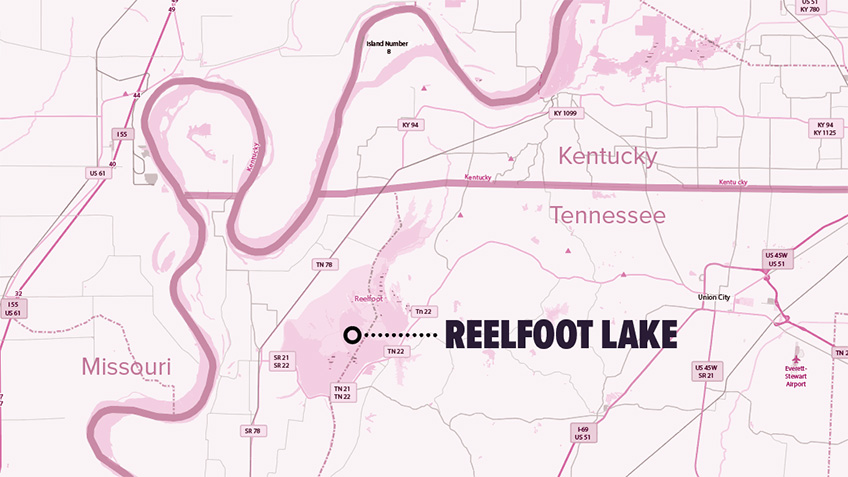
There’s controversy regarding the lake’s name. Some historians believe it was named after a local Chickasaw chief, but the more likely story is the river that flowed where the lake stands today was originally called Redfoot Lake by early explorers and that an error in penmanship resulted in the confusion (mapmakers mistook the “d” in Redfoot for the letters “e” and “l”). In 1818 the Treaty of Tuscaloosa, spearheaded in part by Andrew Jackson, resulted in the U.S. government purchasing 6 million acres in the region from the Chickasaw for the sum of roughly a nickel an acre. In the 1830s, Davy Crockett made his home in a camp near Bluebank Bayou on the lake. The nearby town of Crockett Mills is named in his honor.
In the early 20th century, wealthy investors purchased the entire shorefront of Reelfoot and closed access to locals who relied on the lake for their livelihoods. This didn’t sit well with the local population, and violence erupted. The lake’s new owners were soon subject to raids by local people, and an attorney who had helped facilitate the land purchase was murdered. That led the Tennessee militia to intervene, and ultimately the decision was made to open Reelfoot to public use regardless of who owned the lakefront property.
The violence that plagued the area a century ago is past, and today Reelfoot is a paradise for outdoor enthusiasts. Though it covers 15,000 acres, Reelfoot is very shallow, with a maximum depth of less than 20 feet and an average depth of less than 6 feet. Its shoreline is still shrouded by massive cypress trees, and only the center portion of the lake—the channel of the river that was flooded during the earthquakes of 1811—is devoid of the towering trees. Fishing is a major attraction since the lake is home to huge numbers of panfish, bass and other game fish, and until 2003 it was the world’s only commercial crappie fishery. Bird watchers flock to the area to view the various waterfowl and shorebird species, but the real attraction is bald eagles, which nest in the surrounding cypress groves and feed on the abundant fish.
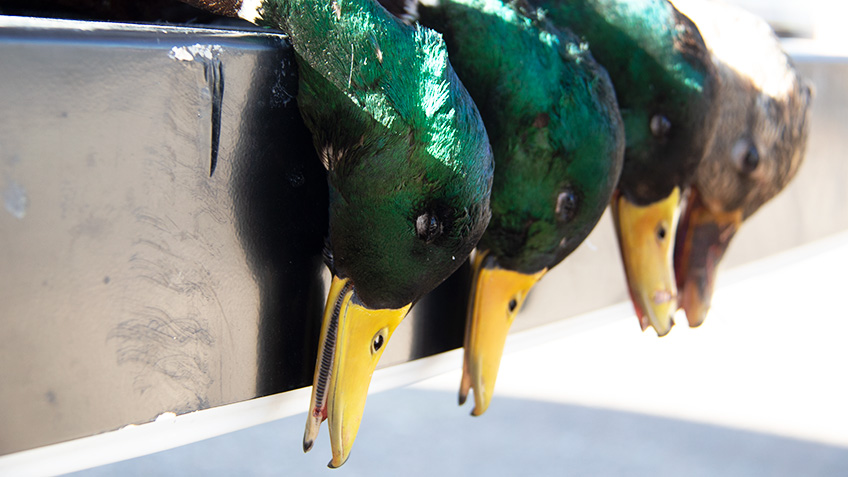
The real draw for hunters, though, is the abundant and varied waterfowl that can be found on Reelfoot. Mallards, blue- and green-winged teal, wood ducks, gadwall, pintail and wigeon are all common targets as they fly south during their annual migration. Additionally, the open water holds large numbers of diving ducks like bufflehead, lesser scaup, goldeneye and ring-necks. The lake’s position on the Mississippi Flyway makes it a magnet for birds during the winter, and hunters from around the country come to Reelfoot in search of a once-in-a-lifetime opportunity for a mixed bag of ducks.
David slipped the War Eagle into Jackie’s covered boat dock and we stepped out onto the deck. Jackie led us into the main room of the blind, the walls of which were lined with chairs and sofas. I was accompanied by Ducks Unlimited’s John Gordon, and as John and I placed our blind bags and shotguns on the outer shooting deck of the blind, David lit the stove and began lining a skillet with slabs of bacon.
“This is impressive, Jackie,” I said as he turned on the television.
“It pretty much has all the comforts of home,” he said, smiling. “It even has a bathroom.” Jackie pulled back one of the heavy rubber flaps that separate the main blind from the shooting deck. “Almost light, boys” he said. “We better get out there.”
When we were positioned on the deck Jackie ordered his Lab into the dog box, an enclosed tunnel that leads from the left-hand corner of the blind to the water.

“Now you stay put,” he said. The eastern horizon was lightening, and in the dim light we could see Jackie’s 1,200-decoy spread floating in the open water in front of the shooting deck. The decoys were motionless on the still surface of the water, and all around the perimeter of the hole great cypress trees rose more than a hundred feet into the sky. I heard ducks winging overhead behind the blind. Across the open water a shorebird slipped along the shoreline on stilted legs, dabbing the shallows with its bill.
“It’s a little bit of heaven, isn’t it?”
“Yes,” I said. “It certainly is.”
Jackie Van Cleave’s entire life has revolved around Reelfoot Lake, and he’s become something of a legend here. He’s never lived far away from the lake’s shores; he’s the third generation of his family to make a living on these waters. His father and grandfather worked the lake as commercial fishermen and guides, spending their summers in search of crappie and panfish and the winters in the duck blind with clients.
“You could say this lake is a big part of my life,” Jackie said as we waited for legal shooting light. “I’ve been guiding duck hunters here for 46 years.”
That’s not a misprint. From the age of 13, Jackie has led duck hunters into these waters he knows so well.
Much has changed since those early days of his duck-hunting career.
“When I started hunting we all used Reelfoot lake boats,” Jackie said. These custom-made wooden-hull boats were also known as “stump jumpers” and featured center seating and bow-facing oars (designed so the captain could watch for cypress knees and logs while steering). Reelfoot boats were a fixture on the lake for more than a century. Around the 1930s the first Reelfoot boats were introduced with inboard motors (generally made from repurposed dishwasher motors) and rudders. Today, however, these boats are seen infrequently on the lake and most remaining wooden Reelfoot boats are in the hands of collectors and museums. One was even displayed at the Smithsonian.
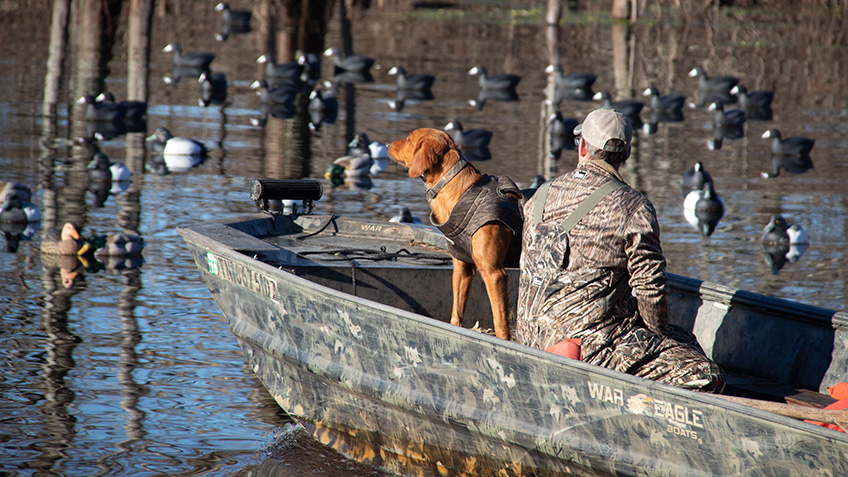
“When I started guiding here, we had clients sit on stumps to hunt,” Jackie said with a laugh. “Could you imagine that today? Clients sitting on a stump?” He laughed again. “Boy, things have changed.”
When shooting light arrived I fed a shell into the chamber of my Winchester SX4 20-gauge and closed the bolt. I hadn’t finished filling the magazine tube when Jackie leaned over to John and me and whispered he saw birds through the trees. Four dark figures winged their way in a wide arc around the hole and turned back, cupping their wings as they dropped from the sky. Mallards, coming hard.
“Take ’em, boys,” Jackie said. I stood and fired just in front of the first bird, crumpling it. John’s Winchester Model 12 roared beside me, and as we shot the other birds flared. John and I took one more from the group, and it landed at the far edge of the hole. I heard a splash from the dog run and saw Jackie’s yellow Lab paddling across the still water.
“That’s what we wanted,” Jackie said. “Y’all be ready, there’ll be more birds in here shortly.”
It didn’t take long. Soon another group of birds appeared almost out of nowhere, and we fired. Our shooting wasn’t as keen that time, but John and I managed to take one bird. We were so excited that we missed a wood duck that whistled across the front of the blind a moment later.
“You got to be watching,” Jackie said. “You boys ready to eat?”
We were off to a good start, and with so many birds in the area it didn’t seem like it would take long to limit. Besides, the smell of frying bacon permeated the shooting deck and I agreed to take a quick break for breakfast and let the area cool. I stepped down into the main hall of the blind and accepted a plate of bacon, eggs and toast from David.
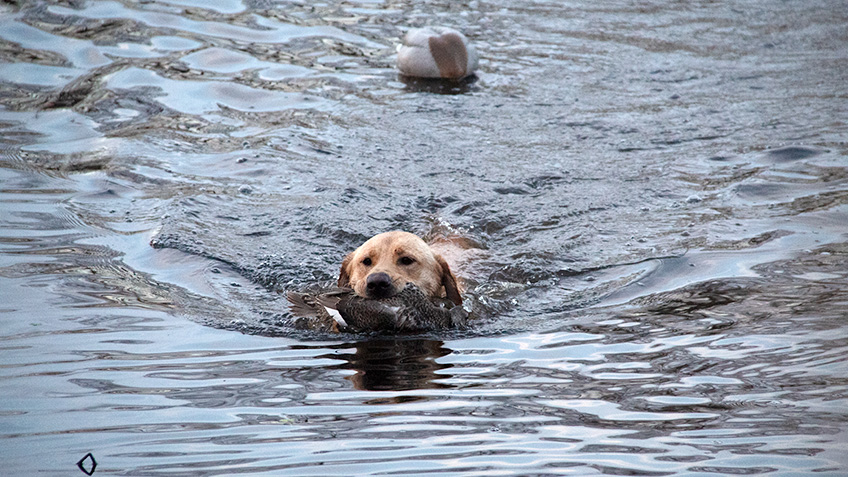
After breakfast, we made our way back up to the deck. The sun was bright by then and the lake shimmered with a very light chop. Jackie’s motion decoys spewed water into the air, and just off the deck a pair of Mojos whirred.
Jackie Van Cleave is a master caller. Working birds has become his passion and profession. Knowing that, I tried to make mental note of the tones, rhythm and intensity he used to draw in passing ducks. He seemed to sense when the birds were committed, even when they were still well outside shotgun range on the far side of the cypress grove. When he said, “Get ready,” it was a safe bet that there would be a shot. Throughout the morning Jackie brought birds into the set, waiting for them to clear the trees and settle before calling the shots. By midmorning the floor of the shooting deck was littered with hulls and John and I had limited out. We ate lunch in the main room.
“So this is your family blind?” I asked. Jackie nodded. “It is until I die. Then they put it into a lottery system. I can’t pass it down.” His tone was rather grim. “It’ll be gone then.”
After lunch we headed back to the marina and said our goodbyes. “Same time tomorrow?” Jackie asked. John and I agreed.
The next morning was more overcast than the first and the wind had picked up, rocking the decoys on the shallow water when the first rays of sunlight filtered through the cypress trees. Shots echoed from a blind behind us right at dawn, and Jackie thought that perhaps they were a minute early. It didn’t sit well with him.
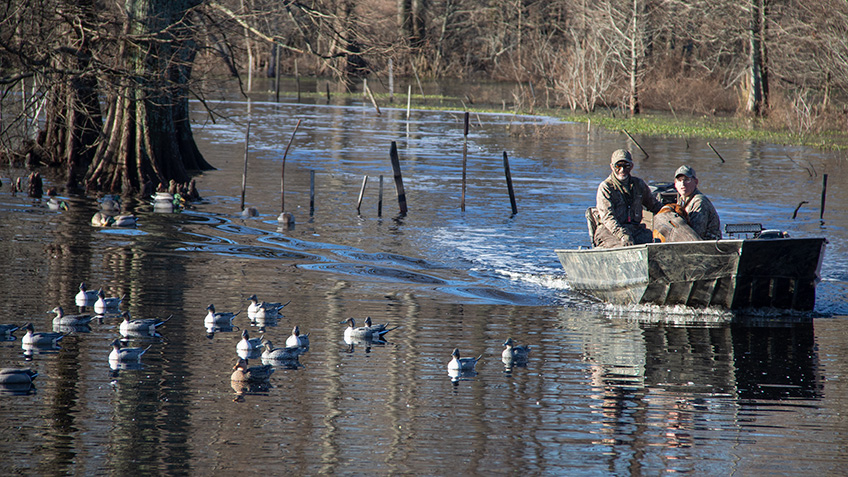
The other hunters seemed to have little effect on our success, though, and while we didn’t experience the intense shooting we’d enjoyed the day before the birds came in steadily. A flock of green-wings buzzed the far edge of the spread, camouflaged against the dark trunks, and even as Jackie called the shot I was still looking for the birds. They flared and disappeared from sight. Jackie simply smiled and shook his head. Soon after another group of birds—mallards this time—came in and we fired. Two birds landed near a clump of grass on the left edge of the decoy spread.
“Wait a minute,” Jackie said. “I have to go get those birds.” A hawk was circling overhead, and mink patrolled the grassy fingers of dry land around the edge of the shooting hole waiting for a lost kill or cripple. Shortly after Jackie disappeared into the main room of the blind I heard the War Eagle roar to life. He captained the boat out to the grass and held up the ducks he found.
“The minks would have had those for sure,” he said when he returned. “Be ready. More birds will be coming.”
I had just a half day to hunt and we quit before noon, still a bird or two short of our limit. But that was fine with me. Reelfoot had been very good to us, and I had plenty of birds in the freezer at the lodge to take home. As we roared across the lake in the boat Jackie pointed out other blinds. He knew most of the owners, though some were lottery blinds. As we sped by one blind, two hunters were loading their gear and the day’s haul of birds into their boat. Jackie shouted a greeting and the hunters shouted back something inaudible to us, offering a hearty wave.
“Most people around here help each other out,” Jackie said. “We’re all out here doing what we love.”
When we landed at the marina David and Jackie began loading the boat on the trailer as John and I offloaded our gear and ducks. In the summer months, Jackie guides anglers on the lake when he isn’t competing in crappie fishing tournaments, and I asked him if I could book a panfishing trip with my family later in the year.
“Of course,” Jackie said with a smile. “You have my number. I’ll be here.”
Of course he would. Reelfoot wouldn’t be the same without him.
Reelfoot requires hunters to purchase a special license in addition to standard state and federal migratory bird permits. There’s a Reelfoot license package available for purchase at the Tennessee Wildlife Resources Agency website, and a HIP number is required.
